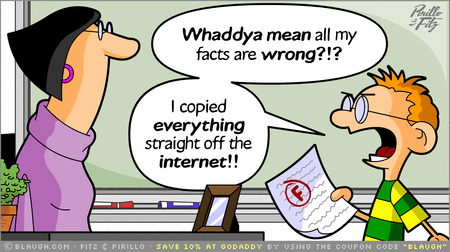
Detecting Plagiarism
by Mauricio Rivera-Quijano SciLIFT
The accessibility of the sources of information, through the internet, created a humongous resource for those trying to cheat the system. The variety of documents, articles, research, and books published on specific topics available now provide a real temptation for students that feel overwhelmed by the amount of work required in their courses.
At the beginning of the semester it is recommended to briefly go over plagiarism with your students, and add the information from this UofA website to your syllabus.
The technology provides now a myriad of potential solutions to facilitate tracking acts of plagiarism. Many of the apps available on the market are used by students, scholars and bloggers.
Grammarly and Whitesmoke are two examples of software well known as spell checker, and robust grammar and punctuation checker tools. However, both now also offer the possibility to check potential plagiarism issues.
As we know, plagiarism can be intentional and unintentional; the first category is clear when the intention of the writers is to use other´s work to save time and effort. The unintentional plagiarism happens when someone transposes the content to their personal style, however keeping the structure and ideas the same. An example of unintentional plagiarism is students from countries where the educational system evaluates the work of students according to their capacity to retain and memorise their professors’ ideas. At times it is respectful to assimilate almost literally what professors teach in class, and use the information in assignments. In North American universities the unintentional act of copying can be considered plagiarism.
You just need to type “plagiarism software” in your browser and you will find a myriad of tools available online. The majority offers a reduced “free version”, and you will need to pay annual fees to obtain fully access to the software. To identify the best tool according to your needs, you might need to visit your librarian to see which one your institution recommends, or read the reviews and comments from users.
The plagiarism checkers have pros and cons, and it seems users select the best according to their needs. In general, those checkers proceed to compare a submitted document with thousands of sources around the world. They use customised algorithm to detect traces of plagiarism like paraphrasing ideas, or the use of synonyms. More sophisticated tools incorporate artificial intelligence strategies into detection methods.
Some plagiarism finding tools:
PlagScan: Developed in Germany is available in 3 European Languages: English, French and German. A trial version is available free.
Articlecheker: This is a copy and paste tool where you obtain a report after the submission. The free version is currently not available.
Plagiarismcheck: A limited free version allows user to submit a single page for free. You can copy and paste or drop your files in many formats. A new feature coming soon will be the integration with Moodle (eClass).
Plagium: A pay per usage web site for occasional use.
PlagiarismChecker: Similar to Plagium
Turnitin offers revision assistance and feedback tools with plagiarism detection, not free.
iThenticate is used by publishers to check citations lists, could be used to publish student’s work.
This short review cannot be finished without a question about the inter linguistic plagiarism.
What happens if someone is writing a paper and uses articles and research published in another language? All the plagiarism checkers did not mention if their algorithms are able to identify a personal interpretation of a source published in other western languages, such French, Spanish, German, and Italian?
The same question applies if the original source has been published in a language that use different alphabet such Arabic, Asian Languages, and others?
This is probably another complexity added to the plagiarism detection challenge for the future.
For further and deeper reviews, consult this research article:
